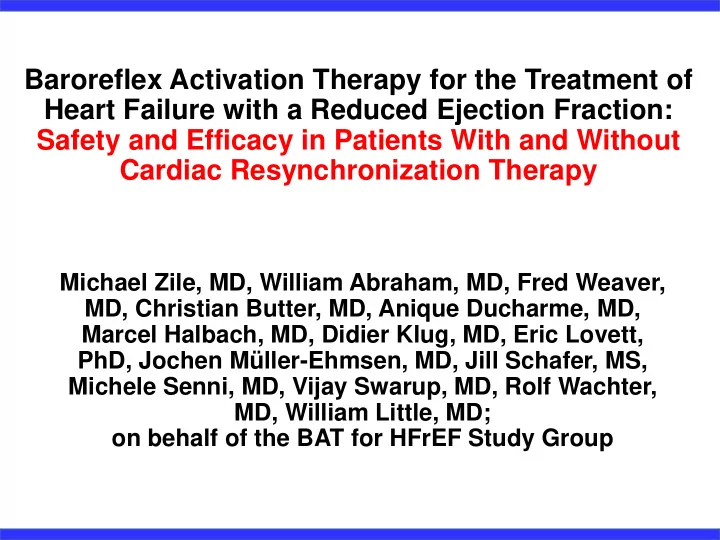

Baroreflex Activation Therapy for the Treatment of Heart Failure with a Reduced Ejection Fraction: Safety and Efficacy in Patients With and Without Cardiac Resynchronization Therapy Michael Zile, MD, William Abraham, MD, Fred Weaver, MD, Christian Butter, MD, Anique Ducharme, MD, Marcel Halbach, MD, Didier Klug, MD, Eric Lovett, PhD, Jochen Müller-Ehmsen, MD, Jill Schafer, MS, Michele Senni, MD, Vijay Swarup, MD, Rolf Wachter, MD, William Little, MD; on behalf of the BAT for HFrEF Study Group
HFrEF Autonomic Nervous System Imbalance Adverse Cardiovascular Remodeling Morbidity & Mortality
HFrEF Baroreflex Activation Sympathetic Parasympathetic
Baroreflex Activation: Mechanism of Therapy in CHF Carotid Baroreceptor Stimulation Afferent Signaling Integrated Autonomic Nervous System Response Inhibits Sympathetic Activity Enhances Parasympathetic Activity ↑ Vasodilation ↑ Diuresis ↓ HR ↓ Elevated BP ↓ Remodeling ↓ Renin secretion Abraham et al, JACC-HF, 2015. In Press: BAT safe and effective, improves clinical status and outcomes in patients with HFrEF
HFrEF Cardiac Resynchronization Sympathetic Parasympathetic “CRT Restores Sympathetic - Vagal Balance By Altering Vagal Signal Transduction ” Demazunder et. al., Circ Res 2015
Study Purpose and Design Purpose: Define the differences in treatment effect produced by BAT in protocol pre-specified groups of patients, those with CRT versus those without CRT. Design: Multi-national, prospective, randomized controlled trial Randomized 1:1 to receive BAT plus optimal medical and device therapy (“BAT Patients”) or optimal medical and device therapy alone (“Control patients”) Enrollment in US, Germany, Italy, France and Canada
Key Enrollment Criteria NYHA Functional Class III Left ventricular ejection fraction ≤ 35% Six-minute hall walk distance 150 - 400 m On stable optimal medical therapy for at least 4 weeks prior to baseline assessment and if indicated, device therapy for at least 6 months No restriction on QRS, concomitant devices, or AF
Baseline Demographics No-CRT CRT Variable (n=95) (n=45) 63 ± 12 68 ± 9 * Age (years) Gender: Female 17% 9% Race: Caucasian 83% 91% NYHA: Class III 99% 100% 48 ± 21 44 ± 24 MLWHF QOL Score 6 Minute Hall Walk Distance (m) 302 ± 81 303 ± 84 HR (bpm) 74 ± 12 72 ± 10 SBP (mmHg) 117 ± 18 118 ± 19 DBP (mmHg) 73 ± 11 70 ± 10 LVEF (%) 25 ± 7 24 ± 6 NT-pro BNP (pg/mL, Median [IQR]) 1144 [534, 3529] 1457 [472, 4603] eGFR (mL/min) 60 ± 20 55 ± 19 History of Coronary Artery Disease 71% 60% History of Atrial Fibrillation 41% 51% HF hospitalizations (over 6 Mo prior 6.3 ± 19 1.8 ± 5.0 to enrollment, days/pt/year) * = p < 0.05 CRT vs. No-CRT
Baseline Medications and Devices No-CRT CRT Variable (n=95) (n=45) Number of Meds 4.6 ± 1.7 4.7 ± 2.0 ACE/ARB 83% 75% Beta-Blocker 86% 86% MRA 58% 48% Diuretic 85% 86% Ivabradine 3% 2% Digitalis 13% 23% Calcium Channel Blocker 9% 5% ICD 85% 91%
Primary Safety Endpoint System or Procedure Related Major Adverse Neurological or Cardiovascular Events (MANCE) at 6 months: CRT: 100% Event-Free Rate 24 Subjects Implanted No-CRT: 96% Event-Free Rate 47 Subjects Implanted
Efficacy Endpoints MLWHF Quality of Life Score Six-Minute Hall Walk Distance Serum Biomarker: NT-proBNP Echo Structure / Function Left Ventricular Ejection Fraction LV Volume Hospitalizations for Worsening Heart Failure Number of Hospitalizations Days Hospitalized
Statistical Analysis Two sets of statistical comparisons: 1- Differences in the changes from baseline to 6 months in BAT compared with Control. CRT analyzed separately from no-CRT patients. 2- Differences in the response to therapy with BAT in CRT compared with the no-CRT patients.
MLWHF QoL Score 10 6 Month Change from Baseline 3.5 0 -0.9 Improvement -10 -9.3 -20 -21.6 p < 0.001 p = 0.23 -30 p = 0.04 -40 BAT Control BAT Control no-CRT CRT
6-MHW Distance 120 6 Month Change from Baseline 85.5 80 Improvement Meters 40 16.4 3.6 0 -3.5 p = 0.003 p = 0.38 -40 p = 0.01 -80 BAT Control BAT Control no-CRT CRT
NT-proBNP 6 Months Change from Baseline 600 433 [64, 537] 400 200 pg/mL 116.0 79.8 [-74, 700] [-452, 402] 0 -97 [-505, 93] -200 p = 0.03 p = 0.16 p = 0.59 -400 BAT Control BAT Control no-CRT CRT
LV Ejection Fraction 6 6 Month Change from Baseline 4.3 4 Improvement 2 % 0 -0.1 -0.1 -1.2 -2 -4 p < 0.03 p = 0.71 p = 0.02 -6 BAT Control BAT Control no-CRT CRT
Heart Failure Hospitalization Days 10 6 Month Change from Baseline 5 0.18 0 -0.13 Improvement -1.05 Days -5 -8.9 -10 -15 p = 0.05 p = 0.75 p = 0.09 -20 BAT Control BAT Control no-CRT CRT
Differences in the response to therapy with BAT in No-CRT compared with CRT patients Measure Estimate P-value Favors QoL Score -12.31 0.040 No-CRT 6MHWD (meters) 69.05 0.010 No-CRT NT-proBNP (pg/mL) -841.32 0.59 No-CRT LVEF (%) 5.51 0.022 No-CRT # HF Hospitalization -8.08 0.09 No-CRT Days
Summary Baroreflex Activation Therapy is safe in HFrEF. BAT significantly improves quality of life score, exercise capacity, NT-proBNP, and possibly the burden of HF hospitalizations. Results were most pronounced and statistically significant in No-CRT patients. Each of these observations should be confirmed in an adequately powered, prospective, randomized clinical outcome trial.
Recommend
More recommend